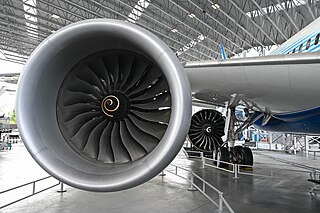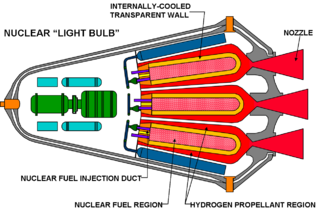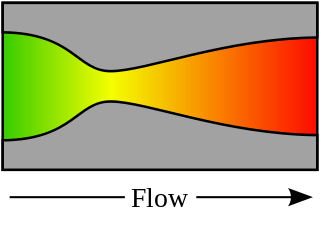Related Research Articles

Spacecraft propulsion is any method used to accelerate spacecraft and artificial satellites. In-space propulsion exclusively deals with propulsion systems used in the vacuum of space and should not be confused with space launch or atmospheric entry.

A magnetoplasmadynamic (MPD) thruster (MPDT) is a form of electrically powered spacecraft propulsion which uses the Lorentz force to generate thrust. It is sometimes referred to as Lorentz Force Accelerator (LFA) or MPD arcjet.

A nuclear thermal rocket (NTR) is a type of thermal rocket where the heat from a nuclear reaction replaces the chemical energy of the propellants in a chemical rocket. In an NTR, a working fluid, usually liquid hydrogen, is heated to a high temperature in a nuclear reactor and then expands through a rocket nozzle to create thrust. The external nuclear heat source theoretically allows a higher effective exhaust velocity and is expected to double or triple payload capacity compared to chemical propellants that store energy internally.
A gas nuclear reactor is a proposed kind of nuclear reactor in which the nuclear fuel would be in a gaseous state rather than liquid or solid. In this type of reactor, the only temperature-limiting materials would be the reactor walls. Conventional reactors have stricter limitations because the core would melt if the fuel temperature were to rise too high. It may also be possible to confine gaseous fission fuel magnetically, electrostatically or electrodynamically so that it would not touch the reactor walls. A potential benefit of the gaseous reactor core concept is that instead of relying on the traditional Rankine or Brayton conversion cycles, it may be possible to extract electricity magnetohydrodynamically, or with simple direct electrostatic conversion of the charged particles.

A fusion rocket is a theoretical design for a rocket driven by fusion propulsion that could provide efficient and sustained acceleration in space without the need to carry a large fuel supply. The design requires fusion power technology beyond current capabilities, and much larger and more complex rockets.

An antimatter rocket is a proposed class of rockets that use antimatter as their power source. There are several designs that attempt to accomplish this goal. The advantage to this class of rocket is that a large fraction of the rest mass of a matter/antimatter mixture may be converted to energy, allowing antimatter rockets to have a far higher energy density and specific impulse than any other proposed class of rocket.
Specific impulse is a measure of how efficiently a reaction mass engine, such as a rocket using propellant or a jet engine using fuel, generates thrust. For engines like cold gas thrusters whose reaction mass is only the fuel they carry, specific impulse is exactly proportional to the effective exhaust gas velocity.

Nuclear pulse propulsion or external pulsed plasma propulsion is a hypothetical method of spacecraft propulsion that uses nuclear explosions for thrust. It originated as Project Orion with support from DARPA, after a suggestion by Stanislaw Ulam in 1947. Newer designs using inertial confinement fusion have been the baseline for most later designs, including Project Daedalus and Project Longshot.

A rocket engine uses stored rocket propellants as the reaction mass for forming a high-speed propulsive jet of fluid, usually high-temperature gas. Rocket engines are reaction engines, producing thrust by ejecting mass rearward, in accordance with Newton's third law. Most rocket engines use the combustion of reactive chemicals to supply the necessary energy, but non-combusting forms such as cold gas thrusters and nuclear thermal rockets also exist. Vehicles propelled by rocket engines are commonly used by ballistic missiles and rockets. Rocket vehicles carry their own oxidiser, unlike most combustion engines, so rocket engines can be used in a vacuum to propel spacecraft and ballistic missiles.
A propellant is a mass that is expelled or expanded in such a way as to create a thrust or another motive force in accordance with Newton's third law of motion, and "propel" a vehicle, projectile, or fluid payload. In vehicles, the engine that expels the propellant is called a reaction engine. Although technically a propellant is the reaction mass used to create thrust, the term "propellant" is often used to describe a substance which contains both the reaction mass and the fuel that holds the energy used to accelerate the reaction mass. For example, the term "propellant" is often used in chemical rocket design to describe a combined fuel/propellant, although the propellants should not be confused with the fuel that is used by an engine to produce the energy that expels the propellant. Even though the byproducts of substances used as fuel are also often used as a reaction mass to create the thrust, such as with a chemical rocket engine, propellant and fuel are two distinct concepts.
A radioisotope rocket or radioisotope thermal rocket is a type of thermal rocket engine that uses the heat generated by the decay of radioactive elements to heat a working fluid, which is then exhausted through a rocket nozzle to produce thrust. They are similar in nature to nuclear thermal rockets such as NERVA, but are considerably simpler and often have no moving parts. Alternatively, radioisotopes may be used in a radioisotope electric rocket, in which energy from nuclear decay is used to generate the electricity used to power an electric propulsion system.
The fission-fragment rocket is a rocket engine design that directly harnesses hot nuclear fission products for thrust, as opposed to using a separate fluid as working mass. The design can, in theory, produce very high specific impulse while still being well within the abilities of current technologies.

Jet propulsion is the propulsion of an object in one direction, produced by ejecting a jet of fluid in the opposite direction. By Newton's third law, the moving body is propelled in the opposite direction to the jet. Reaction engines operating on the principle of jet propulsion include the jet engine used for aircraft propulsion, the pump-jet used for marine propulsion, and the rocket engine and plasma thruster used for spacecraft propulsion. Underwater jet propulsion is also used by several marine animals, including cephalopods and salps, with the flying squid even displaying the only known instance of jet-powered aerial flight in the animal kingdom.

A nuclear lightbulb is a hypothetical type of spacecraft engine using a gaseous fission reactor to achieve nuclear propulsion. Specifically it would be a type of gas core reactor rocket that uses a quartz wall to separate nuclear fuel from coolant/propellant. It would be operated at temperatures of up to 22,000°C where the vast majority of the electromagnetic emissions would be in the hard ultraviolet range. Fused silica is almost completely transparent to this light, so it would be used to contain the uranium hexafluoride and allow the light to heat reaction mass in a rocket or to generate electricity using a heat engine or photovoltaics. This type of reactor shows great promise in both of these roles.

A rocket engine nozzle is a propelling nozzle used in a rocket engine to expand and accelerate combustion products to high supersonic velocities.
A reaction engine is an engine or motor that produces thrust by expelling reaction mass, in accordance with Newton's third law of motion. This law of motion is commonly paraphrased as: "For every action force there is an equal, but opposite, reaction force."
Nuclear gas-core-reactor rockets can provide much higher specific impulse than solid core nuclear rockets because their temperature limitations are in the nozzle and core wall structural temperatures, which are distanced from the hottest regions of the gas core. Consequently, nuclear gas core reactors can provide much higher temperatures to the propellant. Solid core nuclear thermal rockets can develop higher specific impulse than conventional chemical rockets due to the low molecular weight of a hydrogen propellant, but their operating temperatures are limited by the maximum temperature of the solid core because the reactor's temperatures cannot rise above its components' lowest melting temperature.

Rocket propellant is the reaction mass of a rocket. This reaction mass is ejected at the highest achievable velocity from a rocket engine to produce thrust. The energy required can either come from the propellants themselves, as with a chemical rocket, or from an external source, as with ion engines.
A thermal rocket is a rocket engine that uses a propellant that is externally heated before being passed through a nozzle to produce thrust, as opposed to being internally heated by a redox (combustion) reaction as in a chemical rocket.

A pulsed nuclear thermal rocket is a type of nuclear thermal rocket (NTR) concept developed at the Polytechnic University of Catalonia, Spain, and presented at the 2016 AIAA/SAE/ASEE Propulsion Conference for thrust and specific impulse (Isp) amplification in a conventional nuclear thermal rocket.
References
- 1 2 3 4 5 6 7 R. Zubrin (1991). "Nuclear Salt Water Rockets: High Thrust at 10,000 sec ISP" (PDF). Journal of the British Interplanetary Society . 44: 371–376.
- ↑ Angelin, Marcus; Rahm, Martin; Gabrielson, Erik; Gumaelius, Lena (Aug 17, 2012). "Rocket Scientist for a Day: Investigating Alternatives for Chemical Propulsion". Journal of Chemical Education. 89 (10): 1301–1304. Bibcode:2012JChEd..89.1301A. doi:10.1021/ed200848r.
- ↑ Babula, Mariah. "Nuclear Thermal Rocket Propulsion". NASA.gov. NASA Space Propulsion and mission analysis office. Archived from the original on June 11, 2013. Retrieved May 1, 2016.
- ↑ Hasegawa, Koichi (March 2012). "Facing nuclear risks: Lessons from the Fukushima nuclear disaster". International Journal of Japanese Sociology . 21 (1): 84–91. doi:10.1111/j.1475-6781.2012.01164.x.
- ↑ Braeunig, Robert (2005) [1997]. "Rocket propulsion". Rocket & space technology. braeunig.us. Archived from the original on 12 June 2006. Retrieved 1 May 2016.
- ↑ Zubrin, R. (1991). "Nuclear salt water rockets: High thrust at 10,000 sec ISP" (PDF). Journal of the British Interplanetary Society. 44: 371–376 – via narod.ru.
- ↑ Stern, David P., Dr. (19 November 2003). "Far-out pathways to space: Nuclear power". From Stargazers to Starships (Report). Retrieved 14 November 2012.
{{cite report}}: CS1 maint: multiple names: authors list (link) - ↑ Kang, Jungmin; von Hippel, Frank N. (2001). "U-232 and the proliferation-resistance of U-233 in spent fuel". Science and Global Security. 9 (1): 1–32. Bibcode:2001S&GS....9....1K. doi:10.1080/08929880108426485. S2CID 8033110.
- 1 2 Cramer, J.G. (December 1992). "Nuke your way to the stars". Alternate View Column. Analog Science Fiction and Fact . AV-56. Retrieved 2012-03-07.
text also available at
"Alternate View Column AV-56". npl.washington.edu. Retrieved 2017-04-18. - ↑ McNutt, Ralph L. Jr. (31 May 1999). A Realistic Interstellar Explorer (PDF) (Report). Phase I Final Report. NASA Institute for Advanced Concepts. Retrieved 14 November 2012.
